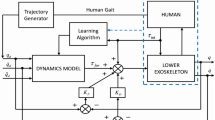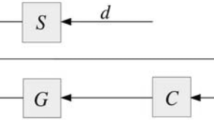Abstract
For several years considerable effort has been devoted to the study of human augmentation robots. Traditionally, the focus of exoskeleton system has always been on model-based control framework. It seeks to model the dynamic system from prior knowledge of the robot as well as the pilot. However, in lower extremity exoskeleton, the control method depends on not only the modelling accuracy but also the physical human–machine interaction changed from personal physical conditions. To address this problem, in this paper, we present a model-free incremental human–machine interaction learning methodology. In a higher level, the methodology can plan the motion of exoskeleton with the sequence of rhythmic movement primitives. In the lower level, the gain scheming is updated from the dynamic system based on a novel proposed learning algorithm efficient \(PI^2\)-CMA-ES. Compared with \(PI^{BB}\), a particular feature is that it directly operates on the Cholesky decomposition of the covariance matrix, reducing the computational effort from \(O(n^3)\) to \(O(n^2)\). To evaluate our proposed methodology, we not only demonstrate its applications on the single leg exoskeleton platform but also test on our lower extremity augmentation device. Experimental results show that the proposed methodology can minimize the interaction between the pilot and the exoskeleton compared with the traditional model-based control strategy.














Similar content being viewed by others
References
Cherry MS, Kota S, Young A, Ferris DP (2016) Running with an elastic lower limb exoskeleton. J Appl Biomech 32(3):269
In H, Jeong U, Lee H, Cho KJ (2017) A novel slack enabling tendon drive that improves efficiency, size, and safety in soft wearable robots. IEEE ASME Trans Mechatron 22(1):59–70
Ortiz J, Rocon E, Power V, de Eyto A, O’Sullivan L, Wirz M, Bauer C, Schülein S, Stadler K S, Mazzolai B, et al (2017) XoSoft–a vision for a soft modular lower limb exoskeleton. Wearable robotics: challenges and trends. Springer, Cham, pp 83–88
Wang L, Du Z, Dong W, Shen Y, Zhao G (2018) Probabilistic sensitivity amplification control for lower extremity exoskeleton. Appl Sci 8(4):525
Wang L, Du Z, Dong W, Shen Y, Zhao G (2018) Intrinsic sensing and evolving internal model control of compact elastic module for a lower extremity exoskeleton. Sensors 18(3):909
Yu W, Rosen J, Li X (2011) PID admittance control for an upper limb exoskeleton. In: Proceedings of the 2011 American control conference, pp 1124–1129. IEEE
Lee S, Sankai Y (2002) Power assist control for walking aid with HAL-3 based on EMG and impedance adjustment around knee joint. In: IEEE/RSJ international conference on intelligent robots and systems, 2002, vol. 2, pp 1499–1504. IEEE
Tran HT, Cheng H, Duong MK, Zheng H (2014) Fuzzy-based impedance regulation for control of the coupled human-exoskeleton system. In: 2014 IEEE international conference on robotics and biomimetics (ROBIO), pp 986–992. IEEE
Aguirre-Ollinger G, Colgate JE, Peshkin MA, Goswami A (2007) Active-impedance control of a lower-limb assistive exoskeleton. In: 2007 IEEE 10th international conference on rehabilitation robotics, pp 188–195. IEEE
Kazerooni H, Racine J L, Huang L, Steger R (2005) On the control of the Berkeley lower extremity exoskeleton (BLEEX). In: Proceedings of the 2005 IEEE international conference on robotics and automation, pp 4353–4360. IEEE
Kazerooni H, Chu A, Steger R (2007) That which does not stabilize, will only make us stronger. Int J Robot Res 26(1):75
Ghan J, Steger R, Kazerooni H (2006) Control and system identification for the Berkeley lower extremity exoskeleton (BLEEX). Adv Robot 20(9):989
Mitrovic D, Klanke S, Howard M, Vijayakumar S (2010) Exploiting sensorimotor stochasticity for learning control of variable impedance actuators. In: 2010 10th IEEE-RAS international conference on humanoid robots, pp 536–541. IEEE
Siciliano B, Sciavicco L, Villani L, Oriolo G (2010) Robotics: modelling, planning and control. Springer, Berlin
Stengel RF (2012) Optimal control and estimation. Courier Corporation, North Chelmsford
Zhou K, Doyle JC, Glover K et al (1996) Robust and optimal control, vol 40. Prentice Hall, New Jersey
Sutton RS, Barto AG (1998) Reinforcement learning: an introduction. MIT Press, Cambridge
Huang R, Cheng H, Guo H, Chen Q, Lin X (2016) Hierarchical interactive learning for a human-powered augmentation lower exoskeleton. In: 2016 IEEE international conference on robotics and automation (ICRA), pp 257–263. IEEE
Huang R, Cheng H, Guo H, Lin X, Zhang J (2017) Hierarchical learning control with physical human–exoskeleton interaction. Information Sciences, London
Veneman JF, Kruidhof R, Hekman EE, Ekkelenkamp R, Van Asseldonk EH, Van Der Kooij H (2007) Design and evaluation of the LOPES exoskeleton robot for interactive gait rehabilitation. IEEE Trans Neural Syst Rehabil Eng 15(3):379
Hogan N (1984) Impedance control: an approach to manipulation. In: American control conference, 1984, pp 304–313. IEEE
Hogan N (1985) Impedance control: an approach to manipulation: part II—implementation. J Dyn Syst Meas Control 107(1):8
Huang H, Crouch DL, Liu M, Sawicki GS, Wang D (2016) A cyber expert system for auto-tuning powered prosthesis impedance control parameters. Ann Biomed Eng 44(5):1613
Alqaudi B, Modares H, Ranatunga I, Tousif SM, Lewis FL, Popa DO (2016) Model reference adaptive impedance control for physical human–robot interaction. Control Theory Technol 14(1):68
Jacobson D, Mayne D (1970) Differential dynamic programming. Elsevier, Amsterdam
Lantoine G, Russell RP (2008) A hybrid differential dynamic programming algorithm for robust low-thrust optimization. In: AAS/AIAA astrodynamics specialist conference and exhibit, pp 152–173
Morimoto J, Atkeson CG (2003) Minimax differential dynamic programming: an application to robust biped walking. IEEE Press, London
Tassa Y, Erez T, Smart WD (2008)Receding horizon differential dynamic programming. In: Advances in neural information processing systems, pp 1465–1472
Li W, Todorov E (2004) Iterative linear quadratic regulator design for nonlinear biological movement systems. In: ICINCO(1), pp 222–229
Todorov E (2009) Efficient computation of optimal actions. Proc Nat Acad Sci 106(28):11478
Todorov E (2006) Linearly-solvable Markov decision problems. In: Advances in neural information processing systems, pp 1369–1376
Todorov E (2008) General duality between optimal control and estimation. In: 47th IEEE conference on decision and control, CDC, pp 4286–4292. IEEE
Williams RJ (1992) Simple statistical gradient-following algorithms for connectionist reinforcement learning. Mach Learn 8(3–4):229
Kober J, Peters JR (2009) Policy search for motor primitives in robotics. In: Advances in neural information processing systems, pp 849–856
Stulp F, Sigaud O (2012) Policy improvement methods: between black-box optimization and episodic reinforcement learning, p 34
Kopp C (2011) Exoskeletons for warriors of the future. Defence Today 9(2):38–40
Bucher D, Haspel G, Golowasch J, Nadim F (2000) Central pattern generators. eLS. Wiley Online Library
Ijspeert AJ (2008) Central pattern generators for locomotion control in animals and robots: a review. Neural Netw 21(4):642
Oliveira M, Matos V, Santos CP, Costa L (2013) Multi-objective parameter CPG optimization for gait generation of a biped robot. In: 2013 IEEE international conference on robotics and automation (ICRA), pp 3130–3135. IEEE
Matsubara T, Morimoto J, Nakanishi J, Sato M, Doya K (2005) Learning sensory feedback to CPG with policy gradient for biped locomotion. In: Proceedings of the 2005 IEEE international conference on robotics and automation, pp 4164–4169. IEEE
Ijspeert AJ, Nakanishi J, Hoffmann H, Pastor P, Schaal S (2013) Dynamical movement primitives: learning attractor models for motor behaviors. Neural Comput 25(2):328
Nakanishi J, Morimoto J, Endo G, Cheng G, Schaal S, Kawato M (2004) Learning from demonstration and adaptation of biped locomotion. Robot Auton Syst 47(2):79
Buchli J, Stulp F, Theodorou E, Schaal S (2011) Learning variable impedance control. Int J Robot Res 30(7):820
Stulp F, Buchli J, Ellmer A, Mistry M, Theodorou EA, Schaal S (2012) Model-free reinforcement learning of impedance control in stochastic environments. IEEE Trans Auton Ment Dev 4(4):330
Wolpert DM, Ghahramani Z, Jordan MI (1995) Are arm trajectories planned in kinematic or dynamic coordinates? An adaptation study. Exp Brain Res 103(3):460
Snelson E, Ghahramani Z (2006) Sparse Gaussian processes using pseudo-inputs. Adv Neural Inf Process Syst 18:1257
Ijspeert AJ (2001) A connectionist central pattern generator for the aquatic and terrestrial gaits of a simulated salamander. Biol Cybern 84(5):331
Theodorou E, Buchli J, Schaal S (2010) A generalized path integral control approach to reinforcement learning. J Mach Learn Res 11:3137
Stulp F, Sigaud O (2012) Path integral policy improvement with covariance matrix adaptation. arXiv preprint arXiv:1206.4621
Hansen N, Ostermeier A (2001) Completely derandomized self-adaptation in evolution strategies. Evol Comput 9(2):159
Igel C, Suttorp T, Hansen N (2006) A computational efficient covariance matrix update and a (1+1)-CMA for evolution strategies. In: Proceedings of the 8th annual conference on genetic and evolutionary computation, pp 453–460. ACM
Eigen M (1973) Ingo Rechenberg Evolutionsstrategie Optimierung technischer Systeme nach Prinzipien der biologishen Evolution. mit einem Nachwort von Manfred Eigen, Friedrich Frommann Verlag, Struttgart-Bad Cannstatt
Stulp F, Schaal S (2011) Hierarchical reinforcement learning with movement primitives. In: 2011 11th IEEE-RAS international conference on humanoid robots (humanoids), pp 231–238. IEEE
Kazerooni H, Steger R, Huang L (2006) Hybrid control of the Berkeley lower extremity exoskeleton (BLEEX). Int J Robot Res 25(5–6):561
Theodorou E, Buchli J, Schaal S (2010) Reinforcement learning in high dimensional state spaces: a path integral approach. J Mach Learn Res 2010:3137
Acknowledgements
We gratefully acknowledge the constructive comments and suggestions of the reviewers.
Funding
Part of this work has received funding from National Natural Science Foundation of China under Grant No. 51521003
Author information
Authors and Affiliations
Corresponding author
Ethics declarations
Conflict of interest
The authors declare that they have no conflict of interest to disclose.
Additional information
Publisher's Note
Springer Nature remains neutral with regard to jurisdictional claims in published maps and institutional affiliations.
Rights and permissions
About this article
Cite this article
Wang, L., Du, Z., Dong, W. et al. Hierarchical Human Machine Interaction Learning for a Lower Extremity Augmentation Device. Int J of Soc Robotics 11, 123–139 (2019). https://doi.org/10.1007/s12369-018-0484-5
Accepted:
Published:
Issue Date:
DOI: https://doi.org/10.1007/s12369-018-0484-5




